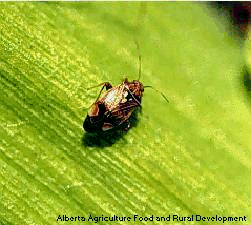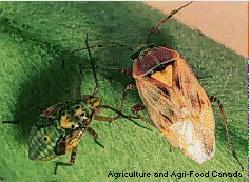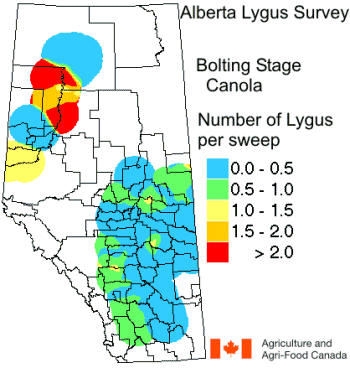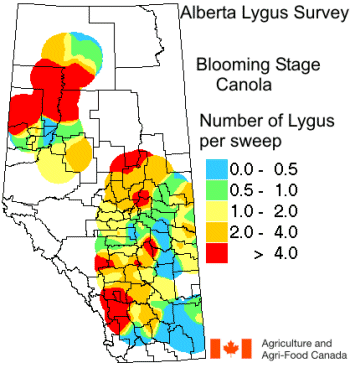| | Description | Host plants | Life history | Damage | Management | Economic threshold | Alberta survey of lygus bugs in canola
Description
Lygus bugs are small, oval-shaped insects that feed on a variety of crops and weeds. Several species infest canola and alfalfa. In Western Canada, Lygus lineolaris (the tarnished plant bug), L. borealis, L. elisus and L. keltoni have been observed destroying canola flower buds and seeds. All four species are thought to be equally destructive.
Detailed information about these bugs is found in the Agriculture and Agri-Food Canada Technical Bulletin No 1992-4E, Lygus Bugs on the Canadian Prairies.
Adult lygus bugs (Figure 1) are about 3 mm wide and 6 mm long. They vary from pale green to reddish brown to black and from fairly uniform color to mottled. Lygus bugs share characteristics with all ‚true bugs™ Œ these include the distinctive, triangular or ‚ 'V'- shaped marking in the upper centre of their backs and membranous wingtips. Adults are active and fly readily when approached.
Immature lygus bugs (nymphs) (Figure 2) are light green and wingless. Young nymphs are often mistaken for aphids, which are similar in size and shape. However, lygus bug nymphs are much more active, are harder bodied and lack the cornicles ("tail pipes") of aphids. Several black spots, usually five, become noticeable on the backs of nymphs as they mature through five instars (growth stages). Wing buds are evident in the fourth and fifth instar.

Figure 1. Lygus lineolaris, the tarnished plant bug adult.

Figure 2. Fifth instar nymph (left) and adult (right).
Host plants
Lygus bugs feed on the sap of new growth and reproductive tissue. Host plants of lygus include alfalfa, canola, lentils, potato, strawberries, vegetable crops, flax, hemp, fababean, tree fruits and weeds such as redroot pigweed, stinkweed, wild mustard and lamb™s- quarters. The tarnished plant bug has more than 300 recorded host species.
Life History
Adult lygus bugs overwinter under plant litter at the soil surface in shelterbelts, headlands, uncultivated areas and field margins. They emerge from hibernation soon after the snow melts in spring. Upon emergence, adults seek winter annuals and the buds of flowering shrubs to feed on. Overwintered adults can be abundant in fall- seeded and early spring-seeded canola, especially if these crops are in bud or flower and other hosts are not yet available.
After mating and once the eggs mature, females seek suitable host plants, such as budding alfalfa or canola, on which to lay their eggs. Egg-laying takes place throughout May, June and July. The first nymphs appear by about the end of May. In the south, the new generation adults first appear by about the end of June.
Generations
The lygus pest species produce at least one generation on the Prairies. Only one generation has been observed north of approximately 53 degrees N latitude (Camrose, Alberta), whereas south of approximately 50 degrees N latitude (Vulcan, Alberta), there can be two generations.
In alfalfa, a new generation can mature about the time the first cut of alfalfa is made for forage. The new lygus bug generation leaves alfalfa seeking another crop, often canola, on which to lay its eggs. Adults move into canola to feed and lay eggs when buds and flowers are developing in June through early July. In canola, the hatch of lygus eggs is complete by the end of July.
After hatching, lygus nymphs feed on new growth and reproductive parts, molting five times before becoming adults. In late summer, the new adults disperse from mature canola fields into later maturing hosts, such as alfalfa, and continue feeding until hibernation.
Damage
Only recently have lygus bugs been considered serious economic pests of canola. In 1996, 10,000 acres were sprayed (the first time canola was treated for a lygus bug infestation) in the Vulcan area. In 1997, lygus damaged canola in the Foothills, Newell, Vulcan, Willow Creek, Bonnyville and Peace River District of Alberta and in the Meadow Lake area of Saskatchewan. Insecticide was applied to about 400,000 acres for lygus bug control that year, yet crop damage was estimated to have exceeded $10 million. In 1998, more than 1,400,000 acres were sprayed to control lygus bugs in Alberta.
New generation lygus bugs have been responsible for most of the reported crop damage in canola. However, with the trend to earlier seeding and fall seeding of canola, overwintered adults have been observed to damage canola in the bud stage.
Lygus bugs use their needle-like mouthparts to suck plant sap from the developing flower buds and seeds. In canola and alfalfa, lygus bug feeding is most injurious to the flowers and developing seeds. The feeding causes visible lesions to surfaces of stems, buds, flowers and pods.
Feeding on buds, flowers and young pods causes ioblastingld, in which buds turn white and fail to develop, flowers fall without forming pods or pods fall without maturing. Seeds that have been fed on will collapse or shrink, as well as darken, and will lose their quality and viability. Additional loss may occur if flowering is delayed by heavy feeding pressure or drought.
Feeding punctures on the outside of pods and stems may ooze droplets of sap, causing an infested crop to become noticeably sticky. These droplets can harbor pathogens. They also create small, dark, circular patches on the pod surface and on the underlying seeds.
In Western Canada, lygus bugs typically damage up to seven per cent of the seed. Adults and the oldest (fourth and fifth instar) nymphs are responsible for most of the feeding injury. In 1997, damage estimates were as high as 40 per cent in the most heavily infested areas.
Management
The damage caused by lygus bugs in canola is related to the weather conditions at the time of the infestation. Weather affects the development of both lygus bugs and the crop.
If rainfall is abundant (more than 100 mm) from the time of bud formation to the end of flowering and if growing conditions are adequate for the rest of the season, canola can compensate for much of the bud damage. Hot, dry weather promotes insect development and worsens the damage caused by insect feeding.
Monitoring
Begin monitoring canola when it bolts and continue until seeds within the pods are firm. Because adults can move into canola from alfalfa, check lygus bug numbers in canola when nearby alfalfa crops are cut.
Economic Threshold
The economic threshold for lygus bugs in canola is applied between the end of the flowering and the early pod ripening stages. Once the seeds have ripened to yellow or brown, the cost of controlling lygus bugs may exceed the damage they will cause prior to harvest.

Figure 3. Sequential sampling for lygus at late flowering stage
Table 1. Economic threshold
| Application Costs |  | Canola Crop Stage * |  |  |  |  |  |  |
| $/ha | $/ac | Bud | End of Flowering |  |  | Pod Ripening |  |  |
| 22 | 8.90 | No economic
threshold available | 14 | 12 | 10 | 20 | 17 | 15 |
| 24 | 9.70 | 16 | 13 | 11 | 22 | 18 | 16 |
| 26 | 10.50 | 17 | 14 | 12 | 24 | 20 | 17 |
| 28 | 11.35 | 18 | 15 | 13 | 25 | 22 | 19 |
| 30 | 12.15 | 19 | 16 | 14 | 27 | 23 | 20 |
| 32 | 12.95 | 21 | 17 | 15 | 29 | 25 | 21 |
| Canola Price |
| $/tonne |  |  | 220 | 260 | 300 | 220 | 260 | 300 |
| $/bu |  |  | 5.00 | 5.90 | 6.80 | 5.00 | 5.90 | 6.80 |
*Crop Staging: 'End of Flowering' to early pod development in the upper canopy is stage 4.4 - 5.1; 'Pod Ripening' is stage 5.2.
Sample the crop for lygus bugs on a sunny day when the temperature is above 20°C and the crop canopy is dry. With a standard insect net (38 cm (15 in.) diameter), take ten 180 degree sweeps. Count the number of lygus in the net.
Repeat the sampling in another 14 locations. Samples can be taken along or near the field margins.
Calculate the cumulative total number of lygus, and then consult the sequential sampling chart (Figure 3). If the total number is below the lower threshold line, no treatment is needed. If the total is below the upper threshold line, take more samples.
If the total is on or above the upper threshold line, calculate the average number of lygus per 10-sweep sample and consult the economic threshold table (Table 1).
Consider your estimated cost of spraying and your expected return prior to making a decision to treat your crop. For example, if an application will cost $26/ha and your expected return is $260/tonne, the threshold level is an average of 14 bugs per 10-sweep sample.
An economic threshold for lygus bugs in canola at the bud stage has not been established.
Cultural control
Cultural control practices such as crop rotation, adjustments to seeding date and cultivation practice are ineffective for controlling lygus bugs.
Biological control
Lygus bugs have several natural control agents. A tiny fairy wasp, in the family Mymaridae, parasitizes the eggs of the lygus bug. In Western Canada, a parasitic wasp, Peristenus pallipes, attacks lygus nymphs in alfalfa but is less effective in canola. Nabid plant bugs, big-eyed bugs and spiders occasionally prey on young lygus bug nymphs.
A European wasp, Peristenus digoneutis, has been introduced into alfalfa fields in eastern North America where it parasitizes about 40 per cent of the tarnished plant bugs. One of the few parasitoids of lygus adults is a tachinid fly, Alophorella sp.
Chemical control
Insecticide application is the only option for control of lygus bugs once populations have reached economic threshold levels. Usually, one application of a registered insecticide at the end of flowering (bloom 90 per cent complete or more) or at upper pod formation will prevent most yield losses. Delaying application may be prudent if nearby alfalfa crops are being cut.
Three insecticides are registered for lygus bug control in canola: Dylox (550 mL/ac), Lorsban 4E (405 mL/ac) and Matador 120EC (34 mL/ac). Use enough water to ensure the insecticide penetrates the canopy and provides adequate coverage.
Bee safety
To reduce direct exposure to pollinators, apply insecticides in very late evening or early morning when bees are not foraging and the crop has completed at least 90 per cent bloom. When treating for lygus, prevent spay drift from moving onto bee hives, blooming weeds or surrounding fields. Notify beekeepers 48 hours in advance of spraying of your intention to treat the field. In general, use an insecticide which has a short residual activity to reduce the impact on pollinators.
Alberta Survey of Lygus Bugs in Canola
A survey of lygus bugs in canola was undertaken in 1998. Co-operators sampled fields throughout Alberta's canola growing area using standard sweep nets. Care was taken to avoid sampling areas of fields that had poor stands or were at a different growth stage from the main part of the field. Samples were taken in the morning under good sweeping conditions.

Figure 4. Density of lygus bugs in canola at bolting stage, Data shown are from 163 fields sampled during June 1998

Figure 5. Density of lygus bugs in canola at late bloom stage, Data shown are from 189 fields sampled during July 1998
The data shown in Figure 4 are from samples collected at ten different locations within each field. Each sample consisted of numbers of lygus bugs in ten walking sweeps. A bolting stage survey was followed by a second survey at the end of flowering (Figure 5).
In general, among fields sampled at both bolting and late bloom stages, fields that had higher numbers of lygus at bolting also had higher numbers at late bloom.
Saskatchewan survey (1998)
Out of 25 fields sampled, only locations in the Meadow Lake area had lygus bug densities exceeding the economic threshold.
Photo and map credits
| Figure 1 | Alberta Agriculture, Food and Rural Development |
| Figure 2 | Agriculture and Agri-Food Canada, Lethbridge |
| Figures 4 and 5 | Agriculture and Agri-Food Canada, Saskatoon |
Prepared by:
Jim Jones, Entomologist, Agronomy Unit, Alberta Agriculture, Food and Rural Development with contributions from Saskatchewan Agriculture and Food, Manitoba Agriculture and Agriculture and Agri-Food Canada.
Source: Agdex 622-20. May 1999. |
|